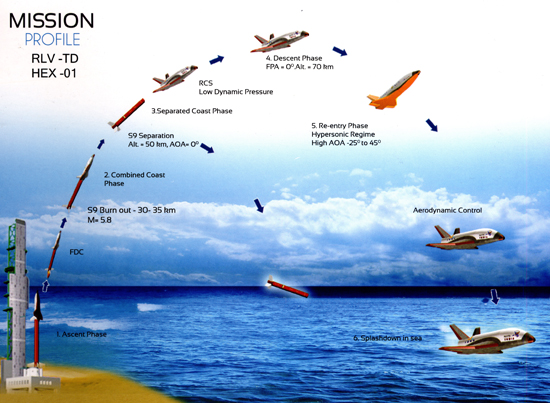Important Facts For Prelims
Reusable Launch Vehicle-Technology
- 04 Apr 2023
- 4 min read
Why in News?
Recently, Indian Space Research Organisation (ISRO) and its partners successfully demonstrated a precise landing experiment for a Reusable Launch Vehicle (RLV) at the Aeronautical Test Range (ATR), Chitradurga, Karnataka.
- An Indian Air Forces (IAF) Chinook helicopter was used to drop the RLV-TD from a 4.5 km altitude and ISRO executed the landing experiment of the RLV-TD as planned.
What is ISRO’s RLV Project?
- About:
- According to ISRO, the series of experiments with the winged Reusable Launch Vehicle-Technology Demonstration (RLV-TD) are part of efforts at “developing essential technologies for a fully reusable launch vehicle to enable low-cost access to space”.
- In the future, this vehicle will be scaled up to become the first stage of India’s reusable two-stage orbital (TSTO) launch vehicle.
- Features and Application:
- ISRO’s RLV-TD looks like an aircraft. It consists of a fuselage, a nose cap, double delta wings, and twin vertical tails.
- The RLV-TD will be used to develop technologies like hypersonic flight (HEX), autonomous landing (LEX), return flight experiment (REX), powered cruise flight, and Scramjet Propulsion Experiment (SPEX).
- Significance:
- With the costs acting as a major deterrent to space exploration, a reusable launch vehicle is considered a low-cost, reliable, and on-demand mode of accessing space.
- By using RLVs the cost of a launch can be reduced by nearly 80% of the present cost.
- With the costs acting as a major deterrent to space exploration, a reusable launch vehicle is considered a low-cost, reliable, and on-demand mode of accessing space.
- Other Previous Experiment:
- ISRO had earlier demonstrated the re-entry of its winged vehicle RLV-TD in the HEX mission in May 2016.
- In HEX, the vehicle landed on a hypothetical runway over the Bay of Bengal. Precise landing on a runway was an aspect not included in the HEX mission.
- The LEX mission achieved the final approach phase that coincided with the re-entry return flight path exhibiting an autonomous, high speed (350 kmph) landing.
- Other Agencies Using RLV or Partial RLV:
- Reusable space vehicles have been in existence for a long time with NASA space shuttles carrying out dozens of human space flight missions.
- SpaceX has been demonstrating partially reusable launch systems with its Falcon 9 and Falcon Heavy rockets since 2017.
- SpaceX is also working on a fully reusable launch vehicle system called Starship.
Conclusion
The successful landing experiment of the RLV-TD programme marks a significant milestone in India’s space technology development. The RLV-TD is an important step towards achieving low-cost access to space, and its successful implementation will benefit India’s space program in the future.
UPSC Civil Services Examination, Previous Year Question (PYQ)
Q. With reference to India’s satellite launch vehicles, consider the following statements: (2018)
- PSLVs launch the satellites useful for Earth resources monitoring whereas GSLVs are designed mainly to launch communication satellites.
- Satellites launched by PSLV appear to remain permanently fixed in the same position in the sky, as viewed from a particular location on Earth.
- GSLV Mk III is a four-staged launch vehicle with the first and third stages using solid rocket motors, and the second and fourth stages using liquid rocket engines.
Which of the statements given above is/are correct?
(a) 1 only
(b) 2 and 3
(c) 1 and 2
(d) 3 only
Ans: (a)







